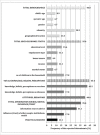Determinants of European parents' decision on the vaccination of their children against measles, mumps and rubella: A systematic review and meta-analysis
- PMID: 27163657
- PMCID: PMC4964810
- DOI: 10.1080/21645515.2016.1151990
Determinants of European parents' decision on the vaccination of their children against measles, mumps and rubella: A systematic review and meta-analysis
Abstract
Low measles, mumps and rubella (MMR) immunization levels in European children highlight the importance of identifying determinants of parental vaccine uptake to implement policies for increasing vaccine compliance. The aim of this paper is to identify the main factors associated with partial and full MMR vaccination uptake in European parents, and combine the different studies to obtain overall quantitative measures. This activity is included within the ESCULAPIO project, funded by the Italian Ministry of Health. ORs and CIs were extracted, sources of heterogeneity explored and publication bias assessed. Forty-five papers were retrieved for the qualitative study, 26 of which were included in the meta-analysis. The following factors were associated with lower MMR vaccine uptake: misleading knowledge, beliefs and perceptions on vaccines (OR 0.57, CI 0.37-0.87); negative attitudes and behaviors toward vaccination (OR 0.71, CI 0.52-0.98); demographic characteristics, such as different ethnicity in Southern populations (OR 0.44, CI 0.31-0.61), higher child's age (OR 0.80, CI 0.76-0.85); low socio-economic status (OR 0.64, CI 0.51-0.80), especially low income (OR 0.39, CI 0.25-0.60) and education (OR 0.64, CI 0.48-0.84), high number of children (OR 0.54, CI 0.42-0.69), irregular marital status (OR 0.80, CI 0.66-0.96). The factors explaining heterogeneity were country location, administration modality, collection setting and responses reported on MMR alone or in combination. Findings from this study suggest policy makers to focus communication strategies on providing better knowledge, correct beliefs and perceptions on vaccines, and improving attitudes and behaviors in parents; and to target policies to people of ethnic minority from Southern Europe, low educated and deprived, with higher number of children and non-married marital status.
Keywords: determinant; measles; mumps and rubella; parents; uptake; vaccine.
Figures






Similar articles
-
Vaccines for measles, mumps and rubella in children.Cochrane Database Syst Rev. 2012 Feb 15;2012(2):CD004407. doi: 10.1002/14651858.CD004407.pub3. Cochrane Database Syst Rev. 2012. Update in: Cochrane Database Syst Rev. 2020 Apr 20;4:CD004407. doi: 10.1002/14651858.CD004407.pub4. PMID: 22336803 Free PMC article. Updated.
-
Vaccines for measles, mumps, rubella, and varicella in children.Cochrane Database Syst Rev. 2021 Nov 22;11(11):CD004407. doi: 10.1002/14651858.CD004407.pub5. Cochrane Database Syst Rev. 2021. PMID: 34806766 Free PMC article.
-
Parents' and informal caregivers' views and experiences of communication about routine childhood vaccination: a synthesis of qualitative evidence.Cochrane Database Syst Rev. 2017 Feb 7;2(2):CD011787. doi: 10.1002/14651858.CD011787.pub2. Cochrane Database Syst Rev. 2017. PMID: 28169420 Free PMC article.
-
Vaccines for measles, mumps and rubella in children.Cochrane Database Syst Rev. 2005 Oct 19;(4):CD004407. doi: 10.1002/14651858.CD004407.pub2. Cochrane Database Syst Rev. 2005. Update in: Cochrane Database Syst Rev. 2012 Feb 15;(2):CD004407. doi: 10.1002/14651858.CD004407.pub3. PMID: 16235361 Updated.
-
Safety of live vaccinations on immunosuppressive therapy in patients with immune-mediated inflammatory diseases, solid organ transplantation or after bone-marrow transplantation - A systematic review of randomized trials, observational studies and case reports.Vaccine. 2017 Mar 1;35(9):1216-1226. doi: 10.1016/j.vaccine.2017.01.048. Epub 2017 Feb 3. Vaccine. 2017. PMID: 28162821
Cited by
-
How a generally well-accepted measles vaccine mandate may lead to inequities and decreased vaccine uptake: a preregistered survey study in Germany.BMC Public Health. 2022 Oct 3;22(1):1846. doi: 10.1186/s12889-022-14075-y. BMC Public Health. 2022. PMID: 36192739 Free PMC article.
-
Determinants of ethnic differences in the uptake of child healthcare services in New Zealand: a decomposition analysis.Int J Equity Health. 2023 Jan 16;22(1):13. doi: 10.1186/s12939-022-01812-3. Int J Equity Health. 2023. PMID: 36647134 Free PMC article.
-
Public health strategies adopted to manage the increase of accesses to vaccination services, as a result of the application of the law 119/2017.Acta Biomed. 2020 Apr 10;91(3-S):35-40. doi: 10.23750/abm.v91i3-S.9413. Acta Biomed. 2020. PMID: 32275265 Free PMC article.
-
Information needed for optimal immunization related to medical advice: an observational prospective cohort study protocol (INFORMed).Front Public Health. 2024 Nov 22;12:1481942. doi: 10.3389/fpubh.2024.1481942. eCollection 2024. Front Public Health. 2024. PMID: 39651470 Free PMC article.
-
Identifying factors that can be used to assess a country's readiness to deploy a new vaccine or improve uptake of an underutilised vaccine: a scoping review.BMJ Open. 2024 May 7;14(5):e080370. doi: 10.1136/bmjopen-2023-080370. BMJ Open. 2024. PMID: 38719292 Free PMC article.
References
-
- Demicheli V, Rivetti A, Debalini MG, Di Pietrantonj C. Vaccines for measles, mumps and rubella in children. Evidence-Based Child Heal 2013; 8:2076-38; http://dx.doi.org/10.1002/ebch.1948 - DOI
-
- European Centre for Disease Prevention and Control Measles and rubella monitoring, July 2015 – Reporting on July 2014 – June 2015 surveillance data and epidemic intelligence data to the end of July 2015. Stockholm: ECDC; 2015.
-
- Pearce A, Mindlin M, Cortina-Borja M, Bedford H. Characteristics of 5-year-olds who catch-up with MMR: findings from the UK Millennium Cohort Study. BMJ Open [Internet] 2013; 3:1-9. PMID:23864213; http://dx.doi.org/10.1136/bmjopen-2013-003152 - DOI - PMC - PubMed
-
- Brown KF, Kroll JS, Hudson MJ, Ramsay M, Green J, Long SJ, Vincent CA, Fraser G, Sevdalis N. Factors underlying parental decisions about combination childhood vaccinations including MMR: A systematic review. Vaccine 2010; 28:4235-48; PMID:20438879; http://dx.doi.org/10.1016/j.vaccine.2010.04.052 - DOI - PubMed
-
- Nagaraj A. Does qualitative synthesis of anecdotal evidence with that from scientific research help in understanding public health issues: A review of low MMR uptake. Eur J Public Health 2006; 16:85-8; PMID:16446303; http://dx.doi.org/10.1093/eurpub/cki058 - DOI - PubMed
Publication types
MeSH terms
Substances
LinkOut - more resources
Full Text Sources
Other Literature Sources
Medical
Molecular Biology Databases
